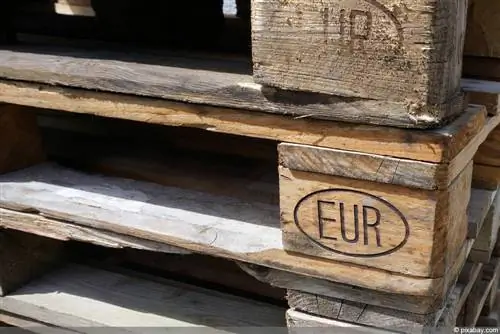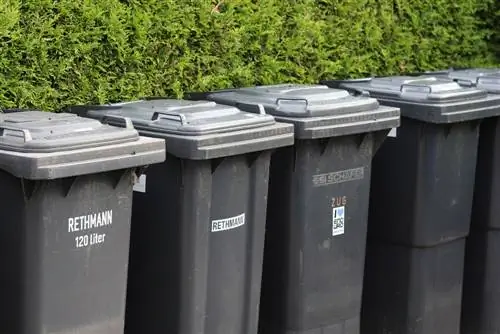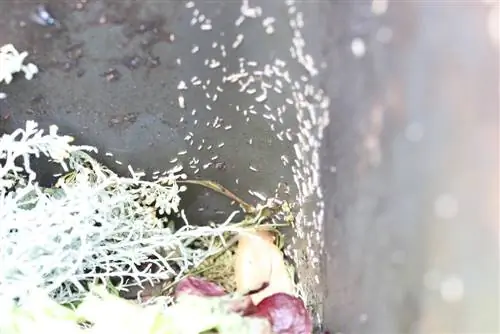- Author admin [email protected].
- Public 2023-12-17 03:39.
- Last modified 2025-01-24 12:45.
Anyone who gets involved with composting will quickly come across the almost endless possibilities for implementation. You can choose between prefabricated rapid and thermal composters or self-built models made from recycled materials. The commercially available composters are convincing in many respects, but they also have weak points. You can avoid this with self-made containers if you take the following aspects into account.
Shady location
In order for the composter to work, the location must be selected with great care. Decomposition processes take place inside, involving microorganisms, beetles, earthworms and many other animals. They need a very special environment so that they can be highly active. These environmental factors include:
- constantly warm temperatures
- constant humidity
- high air circulation
A location in the sun is not suitable as there is a risk of drying out. The sun heats rain barrels, garbage cans or pallet composters too much so that the moisture evaporates quickly. A thermal composter can definitely be placed in the sun if it is covered. Rain barrel composters can also be placed in a shady corner on the balcony. The ideal location ensures:
- partially shaded conditions, e.g. under a tree
- Protection from wind and rain
- no odor nuisance for residents
- comfortable reach
Ideal size
The processes in the compost can only run optimally if the volume is right. If it is too large, small amounts of biological remains are spread over a large area. As a result, the temperature in the mixture cannot be optimally adjusted and the activity of the bioorganisms decreases. If the compost bin is too small, it will not be able to hold enough mass. At the same time, you should adapt the container to the size of your living situation. Small quick composters in the rain barrel are perfect for the balcony, while large thermal composters or self-made objects made from pallets find their place in the garden.
Tip:
The ideal size for the floor space is 1.5 x 1.5 meters. The dimensions may vary in height, although you should allow for at least one meter.
Tons as compost containers
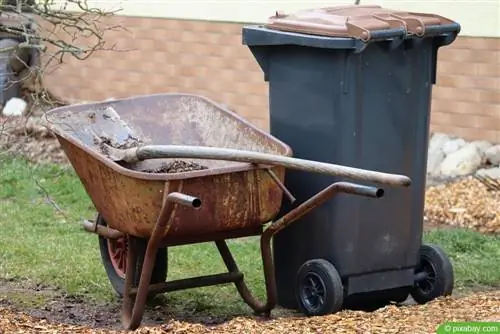
If you have an old rainwater collection container or a worn-out garbage can that can no longer be used for its intended purpose due to brittle spots or cracks, you can give the containers a second life. The advantages of these compost variants are obvious:
- no evaporation through plastic walls
- good heat development inside
- easy handling
- no additional investment costs.
Construction instructions for rain barrel composter
Saw out the bottom with a jigsaw so that a small edge remains. You can use the cut out bottom as a cover later. Place the container upside down in a suitable location and drill holes in the outer wall.
Instructions for garbage can conversion
Saw off the plastic cover holder and the wheel axle holders with a sharp saw. Use a jigsaw to saw a square hole in the middle of the lid, which will later serve as an insertion opening. Place the modified lid on the bottom of the trash can and trace the outline. Saw a second opening in the bottom of the bin. This should be about two centimeters smaller on each edge than the outlined outline so that the lid will later rest on the container. The lid is then attached to the barrel base with a hinge. Ventilation holes are drilled into the wall in the lower area.
Use underlay
Do not place the converted bins directly on the ground, otherwise unwanted pests can get into the compost. To protect against voles, cover the ground with wire mesh. Useful creatures can easily migrate from the substrate through the mesh into the compost.
Increase air supply
So that the microorganisms get enough air, you should fill the bottom of the new compost container with loose coarse material. Pile chopped hedge clippings, branches, straw or brushwood on the ground. You can then dispose of biological remains in the containers. Sufficient air can now flow in from below.
Take off for compost storage
When the hot rush is over, you have to lift the barrels up. This is necessary because the plastic containers are not suitable for long-term storage of mature compost due to their closed surface. With slightly conical shaped rain barrels, it is particularly easy to remove them and the contents then remain standing on their own. Garbage cans are a little harder to handle, so lifting them takes some practice.
Tip:
Put a thick layer of straw on top of the compost pile to protect it from rain. To protect against evaporation, you can form a cover out of strong cardboard on the sides or pile up straw.
Composter made from pallets
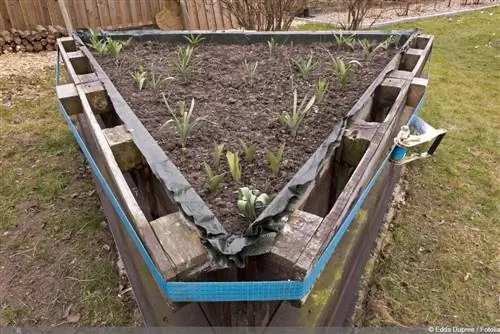
Disused wooden pallets are perfect as compost because they can be put together easily and require little manual skill. They often have the optimal size and ensure optimal air circulation thanks to the wide space between the boards. The wood is also particularly stable because the supports were made to carry large loads. As a natural material, wood poses no he alth risks and will rot over the years along with the compost contents. However, to ensure that neither your he alth nor the environment is endangered, you should pay attention to the following aspects.
Use Euro pallets
In every country, wooden pallets are treated differently, so you should focus on the origin. A burnt-in stamp on the right side provides a clear indication of the region of manufacture. If the letters “EUR” have been burned in here, the wooden pallets definitely come from the European Union. These may only be treated with heat, which is expressed with the abbreviation “HI” (Heat Treatment). If the pallets do not come from the EU, you should keep your distance for the following reasons:
- Wood is often treated with toxic bromomethane
- Substance endangers the environment and he alth
- other toxic wood preservatives are often used
- Particleboard is often glued with adhesives that contain formaldehyde
Note:
Do not use pallets that emit a pungent smell or have the abbreviation “MB”. This indicates the use of bromoethane.
Inform about previous use
Before you start your construction project, you should obtain precise information about the previous use of the wooden pallets. The objects are often used in industry, where they become contaminated. It is more common for containers containing paints, solvents or oils to fall over and the liquids to soak into the wood. The substances then go into the compost and accumulate in the soil.
Thermal and rapid composter
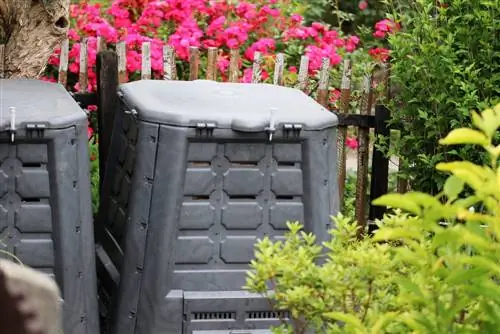
A thermal composter is a type of rapid composter in which rotting can take place particularly quickly thanks to optimal temperature conditions. They consist of a plastic container whose casing acts as thermal insulation. This means the temperature can be kept at a constant level even on cold days. For such models, depending on the version, you will have to plan on spending between 40 and 200 euros. Despite these additional expenses, thermal composters have a few advantages:
- Compost ripe after six to eight weeks
- no additional administration of accelerators necessary
- Costs for the purchase are put into perspective over the period of use
Note mounting systems
The stability varies greatly between these models. Many manufacturers use click or easy lock systems, in which the containers are connected to each other using prefabricated elements. Clamping sleeves and clamps are also used. It is advertised as having a simple structure that does not require any additional tools. But there are weak points where elements have to be connected to one another without additional reinforcements such as nails or screws. These connections can break quickly if the load is too high.
Tip:
Choose a container that is cast in one piece. These composters offer the greatest stability and often outperform other models in terms of durability.
Removal openings
So that you can easily remove the ripe compost, the quick composter should have at least one opening. Most models are equipped with flaps or sliding doors located in the lower part of the front wall. It is ideal if you can remove the ripe substrate from all sides. However, this is an exception for these prefabricated models.

